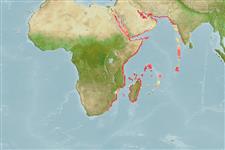>
Blenniiformes (Blennies) >
Tripterygiidae (Triplefin blennies) > Tripterygiinae
Etymology: Enneapterygius: Greek, ennea = nine times + Greek, pterygion = little fin (Ref. 45335).
Environment: milieu / climate zone / depth range / distribution range
Ecologie
marien demersaal; diepte 0 - 12 m (Ref. 12476), usually 0 - 1 m (Ref. 12476). Subtropical
Western Indian Ocean: east and soitheast coast of South Africa (Transkei to southern Mozambique), the Red Sea, Aden, Oman, and Pakistan.
Grootte / Gewicht / Leeftijd
Maturity: Lm ? range ? - ? cm
Max length : 4.0 cm TL mannelijk / geslacht onbekend; (Ref. 11441)
Dorsale stekels (totaal): 14 - 16; Dorsale zachte stralen (totaal): 8-10; Anale stekels 1; Anale zachte stralen: 17 - 20. This species is distinguished by the following characters: D III + XI-XIII + 8-10 (usually III + XII + 10); A I,17-20 (usually 19); pectoral fin 14: 1-3, 4-6, 6-8 (usually 2, 5, 7). LL, pored scales 13-16, notched scales 21-25, starting at 2 scale rows below the end of the pored series; transverse scales 2/6; nape and abdomen scaleless, first dorsal fin base also without scales. Body depth 4.8-5.2 in SL. Head 3.4-4.0 in SL; eyes large, diameter 3.0-3.7 in head length; orbital cirrus moderate, lobate; supratemporal sensory canal U-shaped and embraces 1st dorsal spine; dentary pores 3+1+3. Male first dorsal fin slightly higher than second; slightly lower in females. Key features are: overall olive green; anal fins black and white barred. Males head black; first dorsal fin, lower pectoral-fin rays and proximal portion of the pelvic-fin rays yellow females (Ref. 57774, 88983).
Female members of the Tripterygiidae have eggs that are hemispherical and covered with numerous sticky threads that anchor them in the algae on the nesting sites (Ref. 240). Larvae are planktonic which occur primarily in shallow, nearshore waters (Ref. 94114).
Levenscyclus en paargedrag
Maturiteit | Voortplanting | Paaien | Eieren | Fecunditeit | Larven
Holleman, W. and S.V. Bogorodsky, 2012. A review of the blennioid fish family Tripterygiidae (Perciformes) in the Red Sea, with description of Enneapterygius qirmiz, and reinstatement of Enneapterygius altipinnis Clark, 1980. Zootaxa 3152:36-60. (Ref. 88983)
Status op de Rode Lijst van het IUCN (Ref. 130435)
Gevaar voor de mens
Harmless
Gebruik door de mens
Meer informatie
Lokale namenSynoniemenMetabolismePredatorenEcotoxicologieVoortplantingMaturiteitPaaienPaaiaggregatiesFecunditeitEierenOntwikkeling van de eieren
ReferentiesAquacultuurAquacultuurprofielKweeklijnenGeneticaElectrophoresesErfelijkheidZiektesVerwerkingNutrientsMassaconversie
Tools
Speciale rapporten
Download XML
Internetbronnen
Estimates based on models
Preferred temperature (Ref.
123201): 24.8 - 28.9, mean 27.2 °C (based on 725 cells).
Fylogenetische diversiteitsindex (Ref.
82804): PD
50 = 0.5000 [Uniqueness, from 0.5 = low to 2.0 = high].
Bayesian length-weight: a=0.00562 (0.00258 - 0.01228), b=3.08 (2.89 - 3.27), in cm total length, based on LWR estimates for this (Sub)family-body shape (Ref.
93245).
Trofisch niveau (Ref.
69278): 3.1 ±0.3 se; based on size and trophs of closest relatives
Weerstandsvermogen (Ref.
120179): Hoog, minimale populatieverdubbelingstijd minder dan 15 maanden (Preliminary K or Fecundity.).
Fishing Vulnerability (Ref.
59153): Low vulnerability (10 of 100).
